Dynastic Continuity
Other illustrations in Philip III's Grandes Chroniques develop the dynastic theme of the prologue. These merge, yet differentiate, the sequence of Merovingian, Carolingian, and Capetian rulers that stretches back to Troy, and in the process they celebrate the legitimacy of the Capetians and of Philip III.
Two historiated initials break the pattern of illustrations in the first portion of the manuscript to address the transfer of government from Merovingian to Carolingian. The first (Fig. 8) portrays the coronation of Chilperic II, in a chapter that begins with a rubric, "Ci commence li fait du noble prince Charles Martel," which directs attention away from Chilperic to the mayor of the palace, Charles Martel. The second initial (Fig. 9) celebrates the prowess of Pepin, Charles Martel's
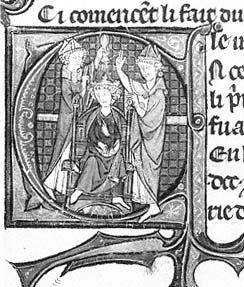
Figure 8
Coronation of Chilperic II. Grandes Chroniques
de France . Bibliothèque Sainte-Geneviève, Ms.
782, fol. 100.
Photograph: Bibliothèque Sainte-Geneviève, Paris.
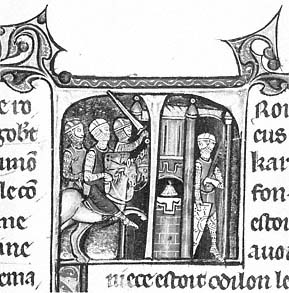
Figure 9
Carloman and Pepin capture Laon from their brother
Grifon. Grandes Chroniques de France . Bibliothèque
Sainte-Geneviève, Ms. 782, fol. 103.
Photograph: Bibliothèque Sainte-Geneviève, Paris.
son and the progenitor of the Carolingian line, shown with his brother capturing the city of Laon. The text describes how, as a reward for his nobility in defending the French realm, Pepin was crowned king of France by the pope, who noted the weakness of the last Merovingian rulers, whom he was deposing, and the strength of Pepin as true governor of the realm.[54]
A second, less explicit break of decorative pattern comes in the book dedicated to the lives of the last Carolingian and early Capetian kings. In this section historiated initials subdivide several chapters outlined in the chapter list. The clusters these form again imply that a transition of dynasties is a reward for good government. A sequence of scenes in one chapter creates a precedent for Capetian rule. In the first cluster (Fig. 10) Normans invade France because the Carolingian king, Charles the Simple, is too young and too weak to govern. In desperation the barons turn to the mayor of the palace, Odo Capet, and crown him king (Fig. 11). Odo governs but remains loyal to young Charles. As soon as Odo dies and the realm reverts to Charles the Simple, the political situation degenerates. The Normans invade again, only to be driven from the realm by the duke of Burgundy (Fig. 12). A second cluster of historiated initials represents the chaos that preceded Hugh Capet's accession to the throne. A sequence of three historiated initials shows the coronation of Louis V, the last Carolingian king (Fig. 13); the conflict between Louis's uncle, Charles, and Hugh Capet's army, which broke out because Hugh would not accept Charles's succession (Fig. 13); and the resolution of the crisis—Hugh Capet, descendant of Odo and, like Odo, mayor of the palace,
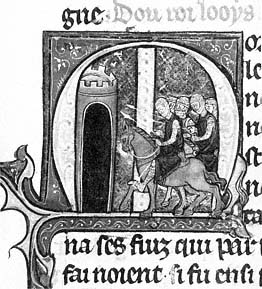
Figure 10
Invasion of the Normans. Grandes
Chroniques de France . Bibliothèque
Sainte-Geneviève, Ms. 782, fol. 208v.
Photograph: Bibliothèque Sainte-
Geneviève, Paris.
becomes king (Fig. 14). As the chronicle describes it, "because Hugh saw that all the heirs and the line of Charlemagne were destroyed and also since [the line] died out and since there was no one to contradict him, he had himself crowned in the city of Reims."[55] Hugh's life does not show his assumption of power but rather depicts him already crowned and exercising his kingly prerogatives, in this case pardoning the count of Flanders at the request of the duke of Normandy.
This handful of historiated initials promotes the idea that the French ruling house draws its legitimacy as much from just government as from blood. Such legitimacy can be confirmed by blood, as the reditus suggests, but it is not necessarily created by it.[56] This view seemed to be foremost at Saint-Denis from the 1260s to 1280s, for it shaped other commissions, including the large sculpted tomb program for the abbey church and the Latin guide to the tombs written by Guillaume de Nangis.[57] The combination of distinct lines unified by the reditus in the tombs and in the Latin Abbreviated Chronicle supports my interpretation of Philip III's program of decoration. All three—the tombs, the Latin chronicle, and the pictorial cycle of Philip III's Grandes Chroniques —trace the lines of office of the French king and note each spot where succession based on good government and succession based on blood diverge. But in each the careful documentation of genealogical discontinuity is secondary to the celebration of continuity of the long line of good governors. This continuity was confirmed by the reditus , which reunified legitimacy of blood with legitimacy of succession to office in the Capetian descendants of Philip Augustus.[58]
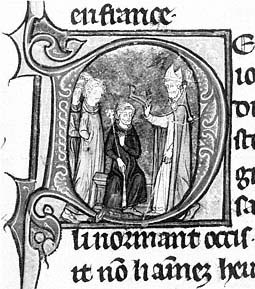
Figure 11
Coronation of Odo Capet. Grandes
Chroniques de France . Bibliothèque
Sainte-Geneviève, Ms. 782, fol. 208v.
Photograph: Bibliothèque Sainte-
Geneviève, Paris.
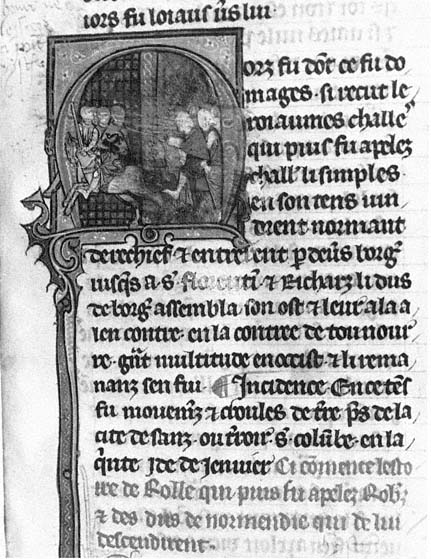
Figure 12
Normans driven from France by the duke of Burgundy. Grandes Chroniques de
France . Bibliothèque Sainte-Geneviève, Ms. 782, fol. 209. Photograph by the author.
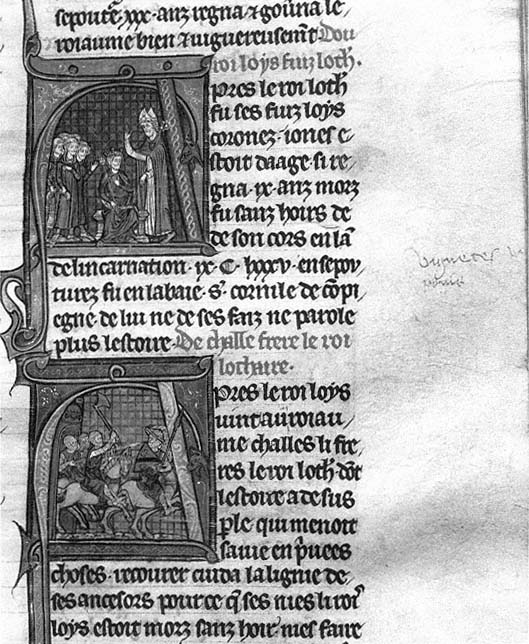
Figure 13
Coronation of Louis V; Army of Charles of Lorraine puts to flight that of Hugh Capet. Grandes
Chroniques de France . Bibliothèque Sainte-Geneviève, Ms. 782, fol. 219. Photograph by the author.
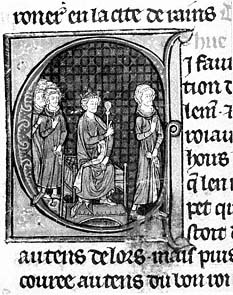
Figure 14
Hugh Capet pardons the count of Flanders.
Grandes Chroniques de France .
Bibliothèque Sainte-Geneviève, Ms. 782, fol.
219v.
Photograph: Bibliothèque Sainte-Geneviève, Paris.